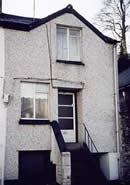Religion was once a very important part
of life – children would not play, men would not work
on the farms and washing would not be hung out on a Sunday.
Families would attend chapel or church once, if not twice,
on the Sabbath. They were also important places of education
and played a large part in the survival of the Welsh language.
Sadly, many of the chapels and churches, especially in rural
areas, have closed and are either ruined or residential.
Calvinistic Methodism became established in Wales in 1811.
This followed a revival of Welsh religion in the 18th century
led by Howel Harris who travelled around Wales preaching in
the Welsh language. The movement brought Welsh bibles into
the communities and started Sunday Schools for both adults
and children thereby improving literacy and keeping the Welsh
language alive.
The Church in Wales - The Disestablishment
and Disendowment of the Church occurred in 1920. The Act placed
the Church on the same footing as non-conformists and it became
independent. |
| top of page |
|
Probably built in the 16th century, although
there is earlier carved stonework around the small north window.
It is dedicated to St Tysilio who was the son of a Prince
of Powys in the early 7th century. The church has a fine medieval
oak roof and, inside, a rare medieval oak lectern.
In the graveyard are the re-interred remains of some of the
skeletons uncovered during excavations at Valle Crucis Abbey
in the mid 19th centuary.
Inside, there are plaques to Robert Browning the poet who
attended church here for ten consecutive Sundays whilst staying
at Bryntysilio Hall as guest of Helen Fawcett, the actress. |
|
top of page |
|
Opened in 1904 although there had been a
chapel on another site in Rhewl since 1826. In 1921 there
was a special service (see photo left) to celebrate the paying
off of the loan that was taken out by the congregation in
order to build the new chapel. Methodism in Rhewl has a history
going back to 1806, woship having originally taken place in
private houses. It is still today a thriving place of worship.
The bier shed was placed at the entrance and was last used
in the 1939’s.
|
|
|
Built in 1829 and enlarged in 1877 to cater
for the increasing number of visitors from surrounding villages.
It is now a private house. |
| top of page |
|
Built in 1822 for the Calvinistic Methodists,
it was extended in 1864. It served the village and a scattered
community of farmers and quarry workers. The chapel closed
in the 1990s and was converted to residential use in 1998.
|
| top of page |
|
Built in 1844 for the
Wesleyans (Samuel Wesley is pictured on the medal shown here), it was the
second chapel in the tiny community of Pentredwr which indicates
the important role of religion at this time. It closed in
1972 and was converted to a private house in 1982. |
|
|
Built in 1871 to provide a place of worship
and a school for the scattered farming community and the quarry
workers. It was a school for 38 years and closed in 1908 when
Pentredwr school was opened. It continued as a church until
1985 and is pictured around 1920. It is now a private house. |
| top of page |
|
Built in 1856 at a cost of £130. As
with St Mary’s Church, the land was donated by Sir William
Watkyn Wynne. Services closed in 1930 and the building was
abandoned, although it still had its roof in the 1950s
(right).
|
|
|
Built between 1715 and 1717 as a private chapel
for the Trevor Hall family. It is claimed that its origins
date back to the 13th century when it was attached to the
Vale Crucis Abbey. It was consecrated as the Chapelry of Trevor
in 1772 when it also served as a school. It continues in se
as a place of worship and is now part of Llangollen Parish.
|
| top of page |
|
This little Roman Catholic church was built
on the site of an ironmongery store between 1 958 and 1961.
The Holy Cross Church
was opened in 1961 (photo right) by Bishop Petit of Menevia.
Previously, the Roman Catholic church was located in a field near Dinas Brân
School. For a short period in the 1940s, the original RC church
in the town was behind the priest’s house in Abbey
Road (photo left). 958 and 1961.
The Holy Cross Church
was opened in 1961 (photo right) by Bishop Petit of Menevia.
Previously, the Roman Catholic church was located in a field near Dinas Brân
School. For a short period in the 1940s, the original RC church
in the town was behind the priest’s house in Abbey
Road (photo left). |
|
|
Welsh Wesleyan chapel opened in 1905 incorporating
a smaller chapel built on the same site in 1840. An earlier
chapel – Capel Pentre Morgan – was built in 1804.
That building now forms part of a row of cottages. |
| top of page |
|
|
Built as a Welsh Congregational chapel, it
was rescued from closure in the late 1970s. The building replaced
a small Welsh Independent chapel, Glan yr Afon which no longer
exists..
|
| top of page |
|
Built in 1846 as the British School. In
the early decades of the 20th century, the school was taken
over by the forward movement of the Welsh Calvinstic Methodst
Chapel. Penllyn Church took over in the 1950s.
|
|
|
The English Baptist Chapel is now a shop
and off-licence. It replaced the earlier Penybryn Chapel ,
now demolished although the cemetery remains. |
| top of page |
|
The Welsh Baptist Chapel was built in 1860.
It recently formed part of the ECTARC complex but now the building
houses the Library and Tourist
Information Centre. |
|
|
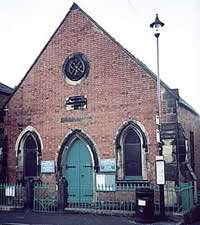 Opened in 1904, the English
Methodist Church (right) replaced a chapel in Market
Street which opened in 1868 and was extended in 1890. The
earlier building (left) is now known as the Memorial Hall Opened in 1904, the English
Methodist Church (right) replaced a chapel in Market
Street which opened in 1868 and was extended in 1890. The
earlier building (left) is now known as the Memorial Hall
|
|
|
Built in 1858 (shown right
around 1860), it was originally intended
as a mortuary church for the new cemetery. In 1870 it became
the flourishing centre for the Welsh congregation of the parish
and as such continues today. |
| top of page |
|
Church in Wales – there has been
a church on this site since the 12th century. It is not known
when the stone church replaced the earlier wooden one. The
church as it is now dates from 1863. It is famous for its
carved oak roof thought to be of 15th century construction.

|
|
|
This was the first Welsh Wesleyan chapel
– built in 1804. It now forms part of a row of cottages
and was replaced by Seion Chapel.
|
| top of page |
|
This was “ built in 1773 for the Calvins
at Pen y Boncyn” (TR 1998). The chapel was replaced
in 1836 by Rehoboth Chapel (Welsh Calvinistic Methodist).
Rehoboth was later enlarged in 1873 but has now ceased to
function as a chapel. |
|
|
“tucked away in a small square at the
side of the Talbot Inn” (TR 1998), the chapel is long
demolished being replaced by the current Glanrafon Chapel
now occupied by the English Evangelical Church.
|
 top of page top of page
|
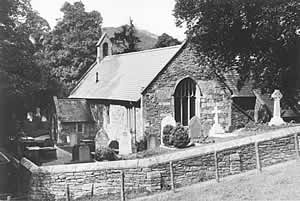
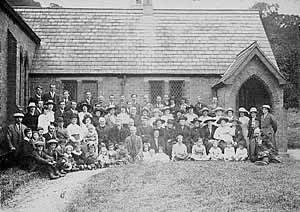

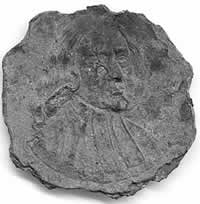
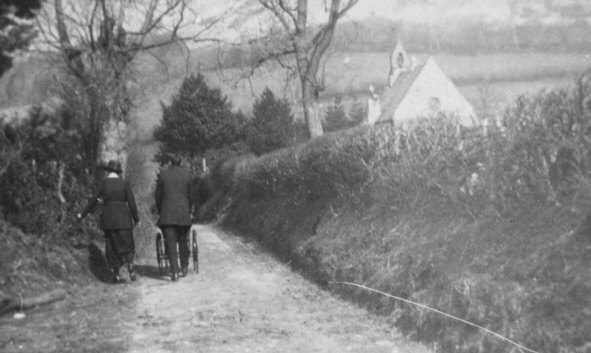

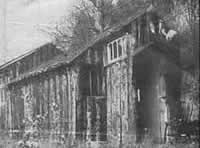
 958 and 1961.
The Holy Cross Church
was opened in 1961 (photo right) by Bishop Petit of Menevia.
Previously, the Roman Catholic church was located in a field near Dinas Brân
School. For a short period in the 1940s, the original RC church
in the town was behind the priest’s house in Abbey
Road (photo left).
958 and 1961.
The Holy Cross Church
was opened in 1961 (photo right) by Bishop Petit of Menevia.
Previously, the Roman Catholic church was located in a field near Dinas Brân
School. For a short period in the 1940s, the original RC church
in the town was behind the priest’s house in Abbey
Road (photo left).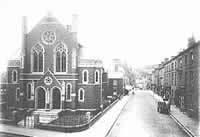
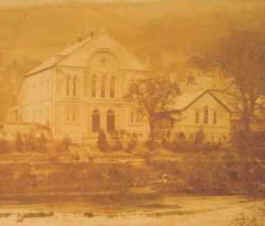
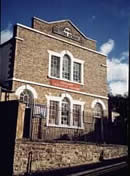
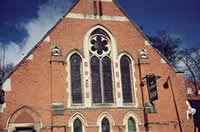
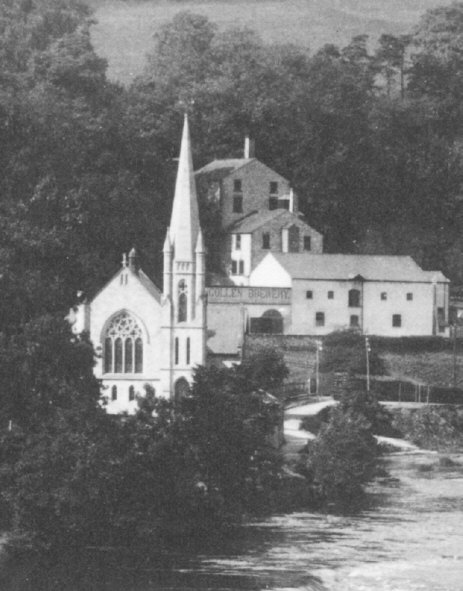
 Opened in 1904, the English
Methodist Church (right) replaced a chapel in Market
Street which opened in 1868 and was extended in 1890. The
earlier building (left) is now known as the Memorial Hall
Opened in 1904, the English
Methodist Church (right) replaced a chapel in Market
Street which opened in 1868 and was extended in 1890. The
earlier building (left) is now known as the Memorial Hall


